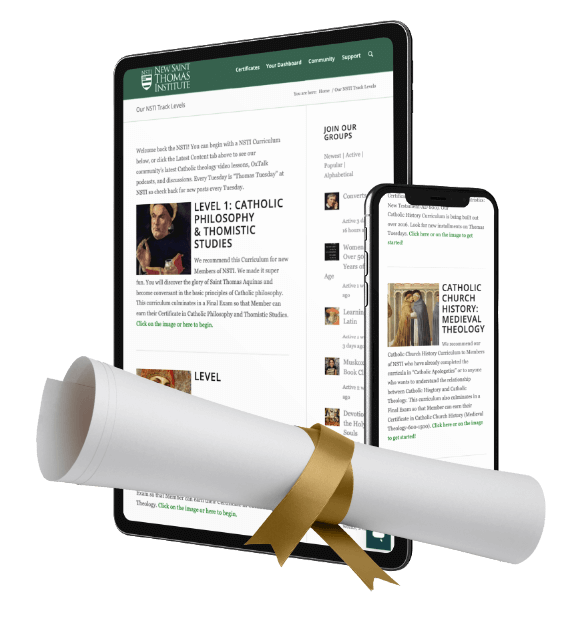Immaculate Mary and Personified Wisdom in the Old Testament
The Old Testament frequently personifies “Wisdom” as an allegorical female who leads righteous men to God. In Hebrew, the word for wisdom is “Chakmah,” in Greek it is “Sophia,” and in Latin it is “Sapientia.” All three words, incidentally, are feminine nouns.
Who, then, is Lady Wisdom? Here are a few options:
1) Lady Wisdom is the pre-incarnate Christ.
2) Lady Wisdom is a type of Mary, the Mother of Christ.
3) Lady Wisdom is an ancient Near Eastern goddess or a feminine Gnostic demigod.
4) Lady Wisdom is purely an allegory of the virtue of wisdom.
Now the Catholic in good faith must reject the third option, since there is no such thing as a goddess in Mosaic Judaism. Nor is the Greek notion of a Sophia goddess permitted to the faithful Catholic. The fourth option cannot be completely correct because the Fathers and the liturgy of the Catholic Church find these “Lady Wisdom” passages to have application to Christ and/or Mary.
So that brings us to options one and two…Wisdom as Christ or Mary.
Saint Paul states the Christ was made for us “the wisdom of God” (1 Cor 1:30). This is true, however, it doesn’t satisfy all the biblical data. Christ is certainly the divine and eternal Wisdom or Word of God. No doubt. However, the Lady Wisdom in Proverbs, Wisdom, and Sirach seems to be somewhat different – most importantly, she is created.
Here are four reasons why the Old Testament’s Lady Wisdom is not a perfect type of Christ:
- In Sirach 24, it specifically states that Lady Wisdom was “created in the beginning” (Sir 24:14). Now we know that our Lord Jesus Christ certainly was not created. To say that Christ is created is to utter the blasphemy of the heresiarch Arius.
- Secondly, Lady Wisdom is always feminine and the Incarnate Christ is male. (By the way, when the heterodox neo-Gnostics speak of Christ as “neuter” or as “Christa” simply remind them of our Lord’s sacred circumcision and that should be the end of it.)
- Third, Lady Wisdom is fulfilled in Proverbs by the closing chapter of the book (Prov 31) in which a true historical virtuous woman fulfills the role of “Wisdom.” This also relates to her status as “mother and mistress.”
- In Sirach 24:14, we learn that God Himself dwelled within this Lady Wisdom: “Then the Creator of all things commanded, and said to me: and he that made me, rested in my tabernacle.” Hence, Lady Wisdom, even in the Old Testament, was the Theotokos or Mother of God.
Okay, so if you have followed me this far, you’re coming to see that the created maternal Lady Wisdom of the Old Testament is a type of the Immaculate Virgin Mary. This has been the unbroken conviction of the Catholic Church, and especially the teaching of the Doctors of the Church such as St Bernard of Clairvaux and St Alphonsus Liguori.
I’d like to emphasize that Lady Wisdom is not Mary per se, but merely the type of the historical Mary. In other words, Mary hasn’t physically existed from all time. Rather she came to be at the Immaculate Conception about 14 years prior to the Incarnation of Christ.
Since Mary is the Immaculate Conception she is the greatest person of God’s creation (recall that Christ is not a created person, but a divine Person). As such, the divine thought of Mary stands above all of creation. When God created ex nihilo, His most perfect intention was to create the Immaculate Mary as the Mother of God without stain or fault. Within creation, Mary is the greatest created person – higher than the angels and more holy than all the saints combined.
For over one thousand years, the Catholic Church has chosen to include liturgical readings that personify “Wisdom as a woman” (from Proverbs, Wisdom, and Sirach) for feasts of our Blessed Virgin Mary. Moreover, the Little Office of the Blessed Virgin Mary places the whole of Sirach 24 as the voice of Lady Wisdom into the mouth of the Immaculate Mary.
Here is one of the passages from Sirach 24 which the Church applies to the Blessed Virgin:
24 I am the mother of fair love, and of fear, and of knowledge, and of holy hope.{*} 25 In me is all grace of the way and of the truth, in me is all hope of life and of virtue. 26 Come over to me, all you that desire me, and be filled with my fruits. 27 For my spirit is sweet above honey, and my inheritance above honey and the honeycomb. 28 My memory is unto everlasting generations.
Obviously, Mary is the “Mother of Fair Love.” Moreover, her memory “is unto everlasting generations” as Mary herself sang in her Magnificat in Luke’s Gospel.
One of my favorite devotional exercises is to pray and read both Sirach 24 and the Magnificat. For this reason, I love the Little Office of the Blessed Virgin Mary – I love it almost as much as I love the Holy Rosary – so that’s really saying something.
If you want to have a rich Lent, I’d encourage you to get the Little Office of the Blessed Virgin Mary – the version below is the best one and it has the Latin and English side by side on the page. I carry it with me every day wherever I go. Stop me on the street, and you’ll find me with a Rosary, the Little Office, and a pocket knife.
O Mary conceived without sin, how I love thee. Thou art all fair and there is no stain in thee. “They that explain thee shall have life everlasting.” Dear Mother, do not forget me in the hour of my death.
If you benefited from this post, please say a Hail Mary for me.
{*} If you visit the Shrine of the Immaculate Conception in Washington DC, you’ll see this verse engraved over one of the altars there dedicated to Mary.
What to Watch Next
SHOP THE TAYLOR MARSHALL STORE
Dive Deeper

GET CONFIDENT IN YOUR FAITH
Explore the fascinating world of Catholic teachings with Dr. Marshall. Together you’ll unpack the brilliant answers the Church gives to tough questions about the Faith. The best part: you go at your own pace. Start this exciting journey today.


 >
>



